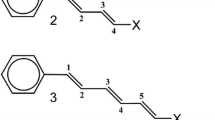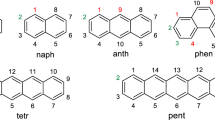Abstract
The transmission of electronic substituent effects through a carbon-carbon triple bond has been investigated from the small changes induced by a variable substituent X on the geometry of the phenyl group in β-substituted phenylacetylenes, Ph−C≡C−X. The geometries of many such molecules were determined by quantum chemical calculations at the B3LYP/6-311++G** level of theory. The structural variation of the phenyl probe is best represented by a linear combination of the internal ring angles, termed SFPHA. Multiple regression analysis of SFPHA using appropriate explanatory variables reveals a composite polar effect. The main components are, in order of decreasing importance: (i) the field effect of the substituent, enhanced by field-induced π-polarization of the −C≡C− spacer, (ii) the resonance-induced field effect, and (iii) the electronegativity effect. These results are compared with those obtained for (E)-β-substituted styrenes, Ph−CH=CH−X, using the same statistical technique, applied to a structural parameter termed SFSTY. The comparison shows that in β-substituted phenylacetylenes, the field effect of the substituent plays a more important role, and the resonance effect a less important, than in (E)-β-substituted styrenes. This is a consequence of the greater polarizability of the C≡C bond as compared with the C=C bond. The role played by the electronegativity of the substituent is the same for the two sets of molecules. A peculiar feature of the −C≡C− spacer is that its π-system consists of two separate parts, corresponding to the two π-bonds that concur to the formation of the triple bond. Only the part orthogonal to the plane of the phenyl probe may interact with the probe π-system, making it possible to transfer π-electron density from substituent to probe, or vice versa. The part coplanar with the phenyl probe may exchange π-electron density with the substituent, but not with the probe. Thus, π-interactions between substituent, spacer, and probe depend critically on the electronic structure and conformation of the substituent. We have classified the substituents in three categories according to the different types of π-interactions that occur in β-substituted phenylacetylenes. First category substituents exchange π-electron density with the orthogonal part of the π-system of the spacer, and hence with the π-system of the probe. While the orthogonal part of the π-system of the spacer acts as a π-electron channel, the coplanar part cannot exchange electrons with the π-system of the phenyl probe. With second category substituents, the conformation of the molecule inhibits the exchange of π-electron density between substituent and probe. The substituent can only exchange π-electrons with the part of the π-system of the spacer that is coplanar with the phenyl probe. Third category substituents exchange π-electron density with both parts of the π-system of the spacer. While the π-charge transferred into the orthogonal part can be further delocalized into the π-system of the phenyl probe, the π-charge transferred into the coplanar part cannot and remains blocked in the spacer. From there, however, it gives rise to an inductive effect that polarizes the π-electron system of the phenyl probe. The π-charge distribution in 45 β-substituted phenylacetylenes and the corresponding (E)-β-substituted styrenes has been determined by Natural Atomic Orbital analysis at the B3LYP/6-311++G** level of theory. The results of the analysis support our classification of the substituents in three categories and reveal the existence of a number of important correlations involving charges as well as structural parameters.









Similar content being viewed by others
References
Campanelli AR, Domenicano A, Ramondo F (2006). J Phys Chem A 110:10122–10129
Campanelli AR, Domenicano A, Piacente G, Ramondo F (2010). J Phys Chem A 114:5162–5170
Campanelli AR, Domenicano A, Ramondo F (2011). Struct Chem 22:449–457
Campanelli AR, Domenicano A (2014). Struct Chem 25:691–698
Campanelli AR, Domenicano A, Ramondo F (2012). J Phys Chem A 116:8209–8217
Campanelli AR, Domenicano A (2013). Struct Chem 24:867–876
Campanelli AR (2013). Struct Chem 24:859–866
Campanelli AR, Domenicano A (2015). Struct Chem 26:1259–1271
Campanelli AR, Domenicano A, Ramondo F (2017). Struct Chem 28:617–624
Campanelli AR, Domenicano A, Hnyk D (2015). J Phys Chem A 119:205–214
Campanelli AR, Domenicano A, Ramondo F (2003). J Phys Chem A 107:6429–6440
Campanelli AR, Domenicano A, Macchiagodena M, Ramondo F (2011). Struct Chem 22:1131–1141
Reed AE, Weinhold F (1985). J Chem Phys 83:1736–1740
Reed AE, Curtiss LA, Weinhold F (1988). Chem Rev 88:899–926
Frisch MJ, Trucks GW, Schlegel HB, Scuseria GE, Robb MA, Cheeseman JR, Scalmani G, Barone V, Mennucci B, Petersson GA, Nakatsuji H, Caricato M, Li X, Hratchian HP, Izmaylov AF, Bloino J, Zheng G, Sonnenberg JL, Hada M, Ehara M, Toyota K, Fukuda R, Hasegawa J, Ishida M, Nakajima T, Honda Y, Kitao O, Nakai H, Vreven T, Montgomery JA Jr, Peralta JE, Ogliaro F, Bearpark M, Heyd JJ, Brothers E, Kudin KN, Staroverov VN, Keith T, Kobayashy R, Normand J, Raghavachari K, Rendell A, Burant JC, Iyengar SS, Tomasi J, Cossi M, Rega N, Millam JM, Klene M, Knox JE, Cross JB, Bakken V, Adamo C, Jaramillo J, Gomperts R, Stratmann RE, Yazyev O, Austin AJ, Cammi R, Pomelli C, Ochterski JW, Martin RL, Morokuma K, Zakrzewski VG, Voth GA, Salvador P, Dannenberg JJ, Dapprich S, Daniels AD, Farkas O, Foresman JB, Ortiz JV, Cioslowski J, Fox DJ (2010) Gaussian 09, Revision C.01. Gaussian, Inc., Wallingford
Domenicano A, Murray-Rust P, Vaciago A (1983). Acta Crystallogr B 39:457–468
Gillespie RJ, Hargittai I (1991) The VSEPR model of molecular geometry. Allyn and Bacon, Boston (2012, Dover, Mineola)
Dakkouri M (1990). Struct Chem 1:179–193
Grindley TB, Johnson KF, Katritzky AR, Keogh HJ, Topsom RD (1974) J Chem Soc Perkin II 273–276
Dawson DA, Reynolds WF (1975). Can J Chem 53:373–382
Denbigh KG (1940). Trans Faraday Soc 36:936–948
Domenicano A, Vaciago A (1979). Acta Crystallogr B 35:1382–1388
Funding
This work was supported by the CINECA Supercomputing Center, Bologna, with Project IsC10_DYNGEO_E, and by the Department of Chemistry, Sapienza – University of Rome, through the Supporting Research Initiative 2013.
Author information
Authors and Affiliations
Corresponding authors
Ethics declarations
Ethical statement
All ethical guidelines have been adhered.
Conflict of interest
The authors declare that they have no conflict of interest.
Electronic supplementary material
The online version of this article (doi:) contains supplementary material, which is available to authorized users.
ESM 1
(DOCX 58 kb)
Rights and permissions
About this article
Cite this article
Campanelli, A.R., Domenicano, A. Structural variation, π-charge transfer, and transmission of electronic substituent effects through the carbon-carbon triple bond in β-substituted phenylacetylenes: a quantum chemical study, and a comparison with (E)-β-substituted styrenes. Struct Chem 30, 9–21 (2019). https://doi.org/10.1007/s11224-018-1199-9
Received:
Accepted:
Published:
Issue Date:
DOI: https://doi.org/10.1007/s11224-018-1199-9




